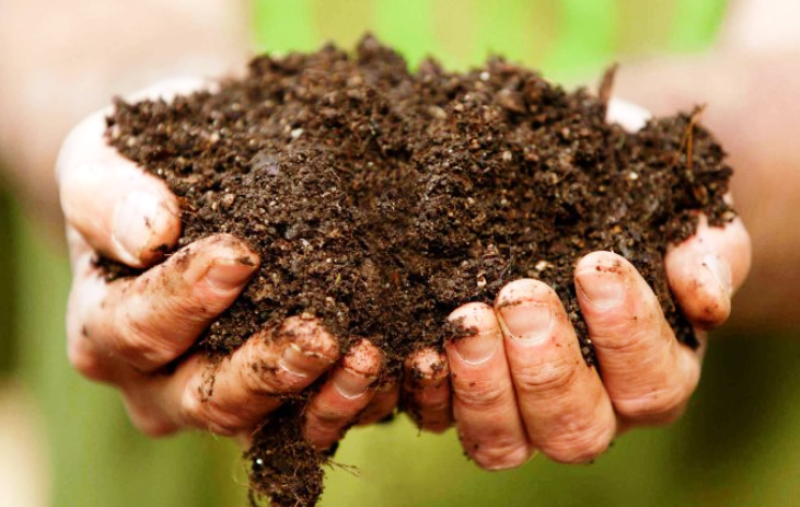
What is composting
COMPOSTING in general is a natural process of rotting or decomposition of organic substance by microorganisms under controlled conditions. Various raw organic materials like food garbage, crop residues, animal wastes, municipal wastes & suitable industrial wastes, improve their suitability for application to the soil as a fertilizing resource, after having undergone composting.
A mass of decomposed organic matter made from waste is known as COMPOST. The compost made from farm waste such as paddy straw, sugarcane trash, weeds & other plants or waste is called farm compost. The average nutrient contents of farm compost are 0.5% N, 0.15% P2O5 & 0.5% K2O. The nutrient value of farm compost could be enhanced by use of superphosphate or rock phosphate at 10 to 15 kg/t of raw material at the early stage of filling the compost pit.
Benefits of Composting
-
Excellent soil conditioner
-
Improves manure handling
-
Reduces risk of pollution
-
Promote higher yields of agricultural crops
-
Reduce or eliminate the need for chemical fertilizers.
-
Composting temperature kills pathogen & weed seeds.
-
During composting all wastes from several sources get blended together.
-
Suppress plant diseases & pests.
-
Remove solids, oil, grease & heavy metals from stormwater runoff.

Different Composting Methods
Indore method of composting
In Indore method of composting, the organic wastes are spread in the cow shed to serve as bedding. Then urine soaked material and dung is removed daily & formed into a layer of around 15 centimeter thick at proper sites. Urine drenched earth, scraped from livestock sheds is mixed with water & sprayed over the layer of wastes 2-3 times a day. Layering process continues for a fortnight or so. After that a thin layer of well decomposed compost is put over top and the heap given a turning & reformed. The old compost works as inoculum for decomposing the material. The pile is left undisturbed for at least one month. Then it is carefully moistened and given a turning. The compost is ready for use in another month.
Coimbatore method of composting
The Coimbatore method basically done in pits of various sizes depending on the available waste material. A coating of waste materials is first spread in the pit. Then it is dampened with a suspension of 5 to 10 kg cow dung in 2.5 - 5.0 liter of water & 0.5 - 1.0 kg fine bone meal sprayed over it evenly. Similar layers are prepared one after another till the material stands 0.75 meter above the ground level. Finally, it is plastered with wet mud & left undisturbed for ten weeks. Then plaster is removed, material is dampened with water, given a turning & made into a rectangular mound under a shade. It is left untouched till use.
Bangalore method of composting
In this method of composting, the dry waste material of 25 centimeter thick is spread in the pit and a broad suspension of cow dung in water is sprayed over for moistening. After that a thin layer of dry waste is laid down over the moistened layer. Alternately, the pit is filled with dry layers of material & cow dung suspension till it reaches 0.5 m above ground level. Then it is left exposed without covering for fifteen days. A turning is given, plastered with wet mud & left untouched for five months or till required.

Coir pith compost
Coir pith has gained importance due to its properties for use as a growth medium in the Horticulture sector. Because of wider carbon & nitrogen ratio & lower biodegradability, coir pith is still not regarded as a good carbon source for use in farming. Coir pith compost is prepared in following way:
How to make coir pith compost
First raw materials are collected. Coir pith is gathered from the coir industry without any fiber. Then a site is selected for composting. The coir pith is an aerobic composting therefore it must be heaped above the soil. Make sure the coir pith should is spread to a length of 4 ft & breadth of 3 ft. At first, coir pith must be put up for 3 inch height & thoroughly moistened. After dampening, nitrogenous source material has to be added. The compost heap must be turned once in ten days to allow the stale air entrapped inside the compost material move out and let fresh air come in.
Also remember that maintaining optimum moisture is the precondition for uniform composting or waste material. The period of composting differ from substrate to substrate. Lastly, the composted material that is obtained from sieving is ready for application. If the composition is not used instantly, it must be stored in a cool, open place, to retain the moisture, so that the useful micro organism present in the compost does not die. Once in a month, water must be sprinkled over the compost material to maintain the moisture.











